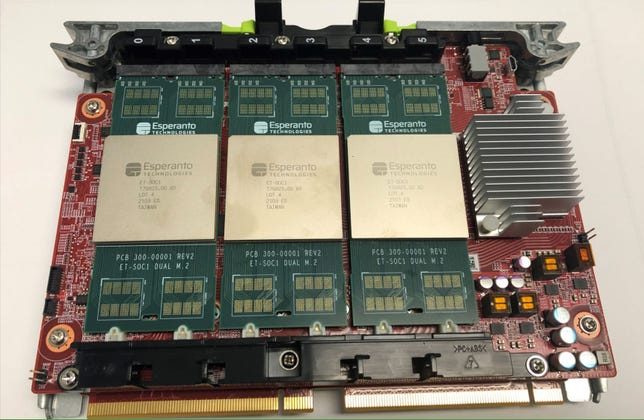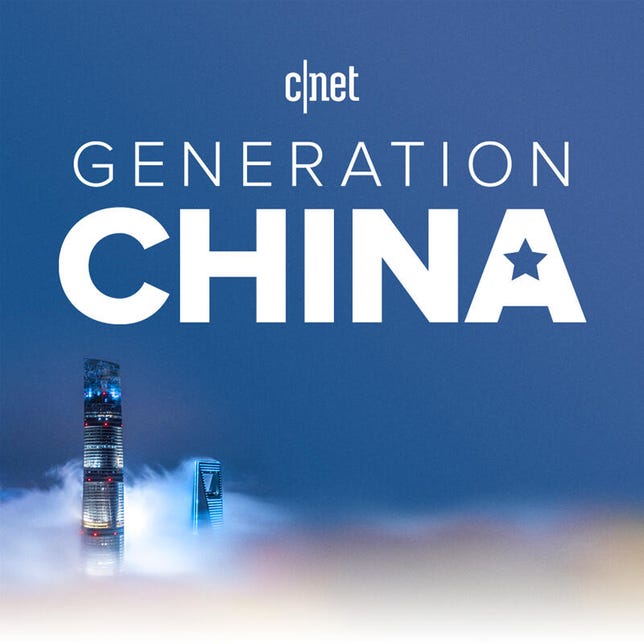The post Chipmakers supercharge AI with giant processor brains first appeared on Joggingvideo.com.
]]>
A host of established companies and fledgling startups are racing to build special-purpose chips to push the capabilities of artificial intelligence technology to a new level. The new chips are geared to help AI grasp the subtleties of human language and handle the nuances of piloting autonomous vehicles, like the ones carmaker Tesla is developing.
Some of the new chips are enormous by the standards of the industry, which has prized miniaturization for decades. One chip for AI acceleration covers 46,225 square millimeters and is packed with 2.6 trillion transistors, the largest ever in the estimation of its designer, Cerebras.
More conventional AI chip work is underway at Intel, Google, Qualcomm and Apple, whose processors are designed to run AI software alongside lots of other tasks. But the biggest chips are coming from reigning power Nvidia and a new generation of startups, including Esperanto Technologies, Cerebras, GraphCore and SambaNova Systems. Their advancements could push AI far beyond its current role in screening spam, editing photos and powering facial recognition software.
Behind the spate of designs is the expectation AI is the next technological gold rush. AI systems, which work by imitating aspects of human brains, are quickly improving at pattern recognition and decision making. Because it has the potential to wrestle with the complexity of the real world, companies like Tesla and Skydio, a drone maker, are betting AI will let their vehicles pilot themselves.
The chip startups unveiled their designs at the Hot Chips conference earlier this week. The conference took place just after Tesla detailed its ambitious Dojo AI training technology and the D1 processor at its heart. At that AI Day event, Tesla Chief Executive Elon Musk said the AI technology is good enough even to help a humanoid robot, the Tesla Bot, navigate the real world.
More powerful AI means advances that aren’t held back by the slow process of AI training. Open AI’s GPT-3, a high-profile AI system for generating human readable text, took four months to train.
AI advances
- Tesla explains how the Full Self-Driving sausage is made
- Nvidia’s Grace AI chip leaves Intel processors behind
- Twitter AI bias contest shows beauty filters hoodwink the algorithm
- Google plans to build a practical quantum computer by 2029 at new center
Enormous AI chips
Everyday computing jobs, like checking your email or streaming a video, mostly involve a single computing task, called a thread. Training an AI model, though, requires a system that can handle vastly more threads at a time.
“AI workloads perform best with massive parallelism,” said 451 Group analyst James Sanders. That’s why AI acceleration processors are among the biggest in the business.

 Enlarge Image
Enlarge ImageEsperanto Technologies’ three-processor accelerator card plugs into a server’s PCIe expansion slot.
Esperanto Technologies
Just about every processor you’ve used, whether in your phone or watching a Netflix video, was originally among many cut from a circular wafer of silicon crystal 300mm across, or about 12 inches. The bigger the chip, the fewer fit on a wafer and more expensive it is to make, in part because there’s a higher likelihood one speck-size defect can ruin an entire unit. Typical general-purpose processors have billions of transistors. For example, the A14 processor in Apple’s iPhone 12 is 88 square millimeters and houses 11.8 billion transistors.
AI chips, customized for the particular needs of AI algorithms and data, start from the same 300mm wafers as other processors but end up being just about the biggest in the business.
Esperanto’s ET-SOC-1 processor is 570 square millimeters with 24 billion transistors, co-founder Dave Ditzel said at Hot Chips. Tesla’s D1 processor, the foundation of the Dojo AI training system that it’s just now begun building, is 645 square millimeters with 50 billion transistors, said Dojo leader Ganesh Venkataramanan. Graphcore’s Colossus Mk2 at 823 square millimeters and 59 billion transistors.
Even bigger: Cerebras AI chip
Cerebras is in still another league for chip size.
Where ordinary processors are cut by the dozen or hundred from a 300mm wafer, Cerebras keeps the full wafer intact to make a single WSE-2 AI accelerator processor. Chipmaking equipment can only etch transistor circuitry on one relatively small rectangular area of the wafer at a time. But Cerebras designs each of those rectangular chip elements so they can communicate with each other across the wafer.
The result: a 2.6 trillion transistor processor covering a whopping 46,225 square millimeters — almost exactly the same area as an 11-inch iPad Pro, although squarer in shape. Interestingly, the company used AI software from chip design firm Synopsys to help optimize its own AI chip circuitry.
Other AI chip companies also link their chips together — Tesla’s Dojo will group 3,000 D1 chips into a single unit it calls an Exapod. But Cerebras’ chip takes integration one step further.
Cerebras counts pharmaceutical giant GlaxoSmithKline and supercomputing center Argonne National Laboratory as customers. The SWE-2 is the company’s second-generation processor.
AI tech: training and inference
Computer scientists have tried for decades to develop AI but have been stymied by the limitations of hardware and software. Technological advances, however, have made the idea practical. AI usually refers to machine learning technology called neural networks that are loosely based on our own billions of interconnected brain cells.
It’s a two-stage technology. Initially, a neural network learns to spot patterns in extremely large sets of carefully annotated data, such as labelled photos or speech recordings accompanied by accurate transcriptions. Training benefits from extremely powerful computing hardware.

 Enlarge Image
Enlarge ImageThe Telum processor in IBM’s newest mainframes, arguably the most conservative server design in the industry, gets circuitry to boost AI software.
IBM
The second phase uses the model that’s been created, a task called inference, and applies it to new material. For example, the AI could be asked to recognize handwriting or spot malicious phishing emails. Computationally, inference is a much less difficult task though it still benefits from acceleration. Some of that happens on the chips Apple, Qualcomm, Intel and others design for consumer devices, and some in the sprawling “hyperscale” data centers that use thousands of servers for giant internet services like YouTube and Facebook.
“The hyperscalers — places like Facebook and Amazon — really do benefit tremendously from AI,” which helps them more intelligently suggest posts you might want to see or products you might want to buy, said Insight 64 analyst Nathan Brookwood.
AI chip challenges
Building AI acceleration chips isn’t easy. Intel scrapped Nervana, its first AI chip. Startup Wave Computing filed for bankruptcy protection in 2020, emerging this year with an attempt at a more ordinary chip licensing business.
And the incumbent technology for training AI systems, high end graphics chips, remain powerful. Tesla’s current AI training system uses Nvidia’s graphics chips, for example.
Nvidia computer architect Ritika Borkar said in a Twitter thread that the flexibility of graphics chips helps the company deal with shorter cycles in AI, a field where techniques change roughly every 18 months.
The post Chipmakers supercharge AI with giant processor brains first appeared on Joggingvideo.com.
]]>The post The US, China and the AI arms race: Cutting through the hype first appeared on Joggingvideo.com.
]]>This story is part of Generation China, CNET’s series exploring the nation’s technological ambition.
Artificial intelligence — which encompasses everything from service robots to medical diagnostic tools to your Alexa speaker — is a fast-growing field that is increasingly playing a more critical role in many aspects of our lives. A country’s AI prowess has major implications for how its citizens live and work — and its economic and military strength moving into the future.
With so much at stake, the narrative of an AI “arms race” between the US and China has been brewing for years. Dramatic headlines suggest that China is poised to take the lead in AI research and use, due to its national plan for AI domination and the billions of dollars the government has invested in the field, compared with the US’ focus on private-sector development.
But the reality is that at least until the past year or so, the two nations have been largely interdependent when it comes to this technology. It’s an area that has drawn attention and investment from major tech heavy hitters on both sides of the Pacific, including Apple, Google and Facebook in the US and SenseTime, Megvii and YITU Technology in China.


Generation China is a CNET series that looks at the areas of technology where the country is looking to take a leadership position.
Brett Pearce/CNET“Narratives of an ‘arms race’ are overblown and poor analogies for what is actually going on in the AI space,” said Jeffrey Ding, the China lead for the Center for the Governance of AI at the University of Oxford’s Future of Humanity Institute. When you look at factors like research, talent and company alliances, you’ll find that the US and Chinese AI ecosystems are still very entwined, Ding added.
But the combination of political tensions and the rapid spread of COVID-19 throughout both nations is fueling more of a separation, which will have implications for both advances in the technology and the world’s power dynamics for years to come.
“These new technologies will be game-changers in the next three to five years,” said Georg Stieler, managing director of Stieler Enterprise Management Consulting China. “The people who built them and control them will also control parts of the world. You cannot ignore it.”
The origins of the US-China arms race
You can trace China’s ramp up in AI interest back to a few key moments starting four years ago.
Related stories
- China is aiming to dominate everything from 5G to social media — but will it?
- Huawei and China-US tensions: Where do we go from here?
- The best smart speakers of 2020: Get hands-free help from Amazon, Google or Apple
- China has big ideas for the internet. Too bad no one else likes them
- 5G will change the world. China wants to lead the way
The first was in March 2016, when AlphaGo — a machine-learning system built by Google’s DeepMind that uses algorithms and reinforcement learning to train on massive datasets and predict outcomes — beat the human Go world champion Lee Sedol. This was broadcast throughout China and sparked a lot of interest — both highlighting how quickly the technology was advancing, and suggesting that because Go involves war-like strategies and tactics, AI could potentially be useful for decision-making around warfare.
The second moment came seven months later, when President Barack Obama’s administration released three reports on preparing for a future with AI, laying out a national strategic plan and describing the potential economic impacts (all PDFs). Some Chinese policymakers took those reports as a sign that the US was further ahead in its AI strategy than expected.
This culminated in July 2017, when the Chinese government under President Xi Jinping released a development plan for the nation to become the world leader in AI by 2030, including investing billions of dollars in AI startups and research parks.


In 2016, professional Go player Lee Sedol lost a five-game match against Google’s AI program AlphaGo.
Google/Getty Images
“China has observed how the IT industry originates from the US and exerts soft influence across the world through various Silicon Valley innovations,” said Lian Jye Su, principal analyst at global tech market advisory firm ABI Research. “As an economy built solely on its manufacturing capabilities, China is eager to find a way to diversify its economy and provide more innovative ways to showcase its strengths to the world. AI is a good way to do it.”
Despite the competition, the two nations have long worked together. China has masses of data and far more lax regulations around using it, so it can often implement AI trials faster — but the nation still largely relies on US semiconductors and open source software to power AI and machine learning algorithms.
And while the US has the edge when it comes to quality research, universities and engineering talent, top AI programs at schools like Stanford and MIT attract many Chinese students, who then often go on to work for Google, Microsoft, Apple and Facebook — all of which have spent the last few years acquiring startups to bolster their AI work.
The impact of coronavirus
China’s fears about a grand US AI plan didn’t really come to fruition. In February 2019, US President Donald Trump released an American AI Initiative executive order, calling for heads of federal agencies to prioritize AI research and development in 2020 budgets. It didn’t provide any new funding to support those measures, however, or many details on how to implement those plans. And not much else has happened at the federal level since then.
Meanwhile, China plowed on, with AI companies like SenseTime, Megvii and YITU Technology raising billions. But investments in AI in China dropped in 2019, as the US-China trade war escalated and hurt investor confidence in China, Su said. Then, in January, the Trump administration made it harder for US companies to export certain types of AI software in an effort to limit Chinese access to American technology.
Just a couple weeks later, Chinese state media reported the first known death from an illness that would become known as COVID-19.
In the midst of the coronavirus pandemic, China has turned to some of its AI and big data tools in attempts to ward off the virus, including contact tracing, diagnostic tools and drones to enforce social distancing. Not all of it, however, is as it seems.
“There was a lot of propaganda — in February, I saw people sharing on Twitter and LinkedIn stories about drones flying along high rises, and measuring the temperature of people standing at the window, which was complete bollocks,” Stieler said. “The reality is more like when you want to enter an office building in Shanghai, your temperature is taken.”


A staff member introduces an AI digital infrared thermometer at a building in Beijing in March.
Xinhua News Agency/Getty Images
The US and other nations are grappling with the same technologies — and the privacy, security and surveillance concerns that come along with them — as they look to contain the global pandemic, said Elsa B. Kania, adjunct fellow with the Center for a New American Security’s Technology and National Security Program, focused on Chinese defense innovation and emerging technologies.
“The ways in which China has been leveraging AI to fight the coronavirus are in various respects inspiring and alarming,” Kania said. “It’ll be important in the United States as we struggle with these challenges ourselves to look to and learn from that model, both in terms of what we want to emulate and what we want to avoid.”
The pandemic may be a turning point in terms of the US recognizing the risks of interdependence with China, Kania said. The immediate impact may be in sectors like pharmaceuticals and medical equipment manufacturing. But it will eventually influence AI, as a technology that cuts across so many sectors and applications.
Speeding the separation
Despite the economic impacts of the virus, global AI investments are forecast to grow from $22.6 billion in 2019 to $25 billion in 2020, Su said. The bigger consequence may be on speeding the process of decoupling between the US and China, in terms of AI and everything else.
The US still has advantages in areas like semiconductors and AI chips. But in the midst of the trade war, the Chinese government is reducing its reliance on foreign technologies, developing domestic startups and adopting more open-source solutions, Su said. Cloud AI giants like Alibaba, for example, are using open-source computing models to develop their own data center chips. Chinese chipset startups like Cambricon Technologies, Horizon Robotics and Suiyuan Technology have also entered the market in recent years and garnered lots of funding.
But full separation isn’t on the horizon anytime soon. One of the problems with referring to all of this as an AI arms race is that so many of the basic platforms, algorithms and even data sources are open-source, Kania said. The vast majority of the AI developers in China use Google TensorFlow or Facebook PyTorch, Stieler added — and there’s little incentive to join domestic options that lack the same networks.
The US remains the world’s AI superpower for now, Su and Ding said. But ultimately, the trade war may do more harm to American AI-related companies than expected, Kania said.


Now playing:
Watch this:
Coronavirus care gets help from AI
0:26
“My main concern about some of these policy measures and restrictions has been that they don’t necessarily consider the second-order effects, including the collateral damage to American companies, as well as the ways in which this may lessen US leverage or create much more separate or fragmented ecosystems,” Kania said. “Imposing pain on Chinese companies can be disruptive, but in ways that can in the long term perhaps accelerate these investments and developments within China.”
Still, “‘arms race’ is not the best metaphor,” Kania added. “It’s clear that there is geopolitical competition between the US and China, and our competition extends to these emerging technologies including artificial intelligence that are seen as highly consequential to the futures of our societies’ economies and militaries.”
The post The US, China and the AI arms race: Cutting through the hype first appeared on Joggingvideo.com.
]]>The post T first appeared on Joggingvideo.com.
]]>
T-Mobile has signed a deal with short movie streaming service Quibi, the companies said on Friday. The carrier will be Quibi’s exclusive wireless distributor when the service launches in April 2020, as reported earlier by the Los Angeles Times.
Meg Whitman, Quibi CEO and former Hewlett Packard Enterprise chief executive, said in an emailed press release the service will “deliver premium video content for millennials on a technology platform that is built exclusively for mobile.”
“A telecommunications partner like T-Mobile, with their broad coverage today and impressive 5G roadmap, is the perfect fit,” Whitman said.
T-Mobile and Quibi said more details of their partnership will be coming soon.
Read more
- 10 best free movie streaming services: Netflix alternatives for 2019
- NBA 2019: How to watch basketball games without cable
- Best live TV streaming services for cord cutters
Originally announced as NewTV, the name of the Hollywood startup was changed to Quibi — short for “quick bites” — in October last year. It received $1 billion in funding from Hollywood studios to launch a service with high-end, short-form shows made especially for mobile users.
Quibi leaders Jeffrey Katzenberg and Whitman last year said some of the content will include a “modern zombie story” created by Guillermo del Toro, an anthology called 50 States of Fear by Spider-Man director Sam Raimi, a project called Wolves and Villagers from the production company that made Get Out and a modernization of Dog Day Afternoon.
The service was originally expected to launch by late 2019 at a cost of $5 a month with advertising, or $8 a month ad-free.
2019 movies to geek out over






+74 more
The post T first appeared on Joggingvideo.com.
]]>The post Sex tech startups protest outside Facebook over banning of ads first appeared on Joggingvideo.com.
]]>
Supporters, founders and employees of sex tech and women’s wellness startups like Dame Products and Unbound Babes assembled outside Facebook’s New York office Wednesday. The crowd protested the social media site’s policies, which don’t let the companies run ads for their products.
Polly Rodriguez, CEO and co-founder of Unbound Babes, told CNET the event had a turnout of 40 to 50 founders, activists and educators.
“Our goal was to raise awareness … and I feel pretty strongly we did just that,” Rodriguez said in an emailed statement.
Today a group of female founders protested in front of Facebook’s NYC office to raise awareness on the double standard in their ad policies. Head over to https://t.co/gKBK0mB7kq to see for yourself. https://t.co/QXXn59s1MF via @qz https://t.co/6GzkjhBlGv
— Polly Rodriguez (@polly_claire) July 31, 2019
Alexandra Fine, CEO and co-founder of Dame Products, added that the inability to advertise “created a great deal of drag on our mission.”
“Advertising is a necessary and important part of connecting people to valuable solutions,” she said Wednesday. “There are millions of people who stand to improve their lives with our products, and they will have no idea we exist until we’re allowed to make contact with them. This doesn’t just impact a few businesses — it impacts the health and happiness of everyone who has sex.”
The protests were along the lines of the Approved, Not Approved website that the two startups launched earlier this month. Approved, Not Approved is a game that lets you guess whether an advertisement was OK’d for public consumption.


Dame Products / Unbound
In June, Dame Products also sued the New York Metropolitan Transportation Authority for rejecting its ads for vibrators.
The sex tech protest isn’t the first protest Facebook’s New York office has seen. In June, dozens of anticensorship activists shed their clothes to protest the social media site’s nudity rules. In the wake of the protest, Facebook began talks with the activists over a compromise.
The social media site appears to be taking the same approach this time.
“We have had open lines of communication with both companies about our policies and are always taking feedback. We are working to further clarify our policies in this space in the near future,” a Facebook spokesperson said in an email.
Facebook also pointed out its advertising policy that refers to adult products and services. The policy says ads can’t promote any adult products and services apart from family planning and contraception. In the case of contraceptives, the ad must focus on the “contraceptive features” of the product and not “sexual pleasure or sexual enhancement.” The ad also has to be targeted to users 18 years or older.


Now playing:
Watch this:
CES 2019: Sex tech is everywhere and nowhere
19:34
The post Sex tech startups protest outside Facebook over banning of ads first appeared on Joggingvideo.com.
]]>The post Qualcomm bets $100M on new AI venture fund first appeared on Joggingvideo.com.
]]>
When it comes to AI, Qualcomm’s betting big.
The company said on Wednesday that it plans to start a venture fund that will invest at least $100 million in early stage startups working on artificial intelligence. In particular, the fund will look at companies finding ways to do intensive data processing on devices like smartphones and security cameras instead of in remote cloud systems.
“If you look at the smartphone today, this is one of the biggest AI platforms,” Quinn Li, head of Qualcomm Ventures, said in an interview. “We want to make edge AI a ubiquitous platform.”
Qualcomm is just the latest company to make big investments in artificial intelligence. Companies such as Google have long focused on the technology, and handset giant Samsung said in June that its Silicon Valley-based Samsung NEXT business had launched a fund to invest in early-stage startups devoted to “solving AI problems, as well as those using AI to solve computer science problems.”


Now playing:
Watch this:
Google wants to solve big problems with AI
2:45
Artificial intelligence has the potential to change the way we use technology and even live. Anyone who carries a modern smartphone uses AI through Apple’s Siri or Google’s Assistant. Meanwhile, Amazon’s Alexa has become popular for speakers and other smart home devices. Samsung jumped into the market last year with its Bixby digital assistant for controlling your Galaxy smartphone, TV or refrigerator.
As the world’s biggest maker of chips for mobile devices, Qualcomm hopes to get insight into the future of AI and what’s needed from its processors. The company and many others in the semiconductor industry have been focusing on new AI chips that can rapidly process information and return results to users.
On Wednesday, Qualcomm unveiled an investment in AnyVision, a startup that developed body and facial recognition technology “that is both highly accurate and mitigates privacy concerns through the use of on-device AI.”
AnyVision has “a unique approach to AI, particularly around facial recognition,” Li said. Its technology performs well in “real-life scenarios where you may not have the perfect shots of faces.”
Rethinking the SoftBank Vision Fund?
When deciding where to invest its money, the main consideration for Qualcomm is finding companies that fit well with its chief business, supplying chips that act as the brains of devices and connect to wireless networks. The chipmaker has been investing in startups since 2000 and focuses on mobile/5G, AI, automotive, the internet of things, and networking companies.
Qualcomm Ventures’ investment companies have included Ring, which Amazon purchased, and Xiaomi, one of the biggest smartphone companies in China.
It also invested in SoftBank’s nearly $100 billion Vision Fund, which reportedly has been changing the face of startup investments. Li said Qualcomm Ventures became a “small” investor in the Vision Fund after being approached by SoftBank, but he declined to specify how much it contributed.
See also
- Uber stuck between a rock and a hard place with Saudi investment
- Qualcomm’s ex-CEO departs board, mulls taking company private
- Qualcomm’s new chips fix a major problem for 5G phones
He views the fund as a potential “kingmaker” through the bets it makes — and the large amount of cash it gives startups.
“They do invest a lot of money,” Li said. Those funds give one company the “ability to really scale the business past the competition” by investing more in R&D, sales and marketing.
Still, Qualcomm may not invest in a possible second Vision Fund, Li said.
SoftBank and the Vision Fund have faced scrutiny recently over their ties to Saudi Arabia. The Middle Eastern country contributed $45 billion to the first fund and said in October that it would contribute the same amount to a second fund.
But some companies no longer want to have ties to Saudi Arabia following the death last month of Jamal Khashoggi, a prominent Saudi dissident and critic of the Saudi government. The government of Turkey said The Washington Post columnist was strangled and dismembered at the Saudi Consulate in Istanbul on Oct. 2 by a 15-member assassination squad, as noted by CNET parent company CBS. Saudi Arabia ultimately said its agents strangled Khashoggi during a fight inside the consulate.
But many people, including some US lawmakers, believe Saudi Crown Prince Mohammed bin Salman had some role in ordering the murder. And the CIA this month substantiated the report about the crown prince’s role, according to CBS.
Li on Wednesday said Qualcomm Ventures isn’t sure yet if it would invest in a second Vision Fund, in light of the controversy surrounding Saudi Arabia.
“For the first one, we had a long relationship with SoftBank, and the money they raised from the Saudis … wasn’t an issue,” Li said. “Now, going forward, certainly we’d have to understand what it means to be investing with the Saudis.”
He noted there are already concerns about the Saudi connection, no matter what conclusions are reached about Khashoggi’s death.
“We have a lot of relationships with the US government,” Li said. That includes selling it mobile technology. “We need to take into account at the Qualcomm level the business risk involved.”
First published Nov. 28, 2:30 p.m. PTUpdate, 4:53 p.m.: Adds information from an interview.
CNET’s Holiday Gift Guide: The place to find the best tech gifts for 2018.
Taking It to Extremes: Mix insane situations — erupting volcanoes, nuclear meltdowns, 30-foot waves — with everyday tech. Here’s what happens.
The post Qualcomm bets $100M on new AI venture fund first appeared on Joggingvideo.com.
]]>The post Apple starts Entrepreneur Camp to help female app developers first appeared on Joggingvideo.com.
]]>
Apple wants to help give female developers a boost when it comes to iOS apps.
The company on Monday unveiled its new Entrepreneur Camp that’ll help women with an intensive coding lab, specialized support and ongoing mentoring. It’ll bring women to its Cupertino, California, headquarters for two weeks each quarter to help them with one-on-one sessions for coding, marketing and other areas to successfully launch their apps.
“It’s a fact that women are underrepresented in the industry,” Esther Hare, Apple senior director of worldwide developer marketing and executive sponsor of Women @ Apple, said Monday in an interview. “And there’s a huge disparity [in the] entrepreneur world when it comes to access and funding. There’s an opportunity to do more and give exposure to women-led businesses.”


Now playing:
Watch this:
5 best smartwatches and fitness trackers for your holiday…
2:19
To be eligible, the company must be founded, co-founded or led by a woman — including transgender women — and must have at least one woman on the development team. The company also has to have a working app or prototype. That could include having an Android app but no iOS version, or having an idea for adding something like augmented reality to an app that’s already in Apple’s App Store, Hare said.
“This is really the first of its kind, one-on-one, code-level camp for women … to fast-track app development,” she said.
There’s been more scrutiny this year about the number — and treatment — of women in technology. The #MeToo movement has brought to light sexual harassment and other issues women have faced, including by high-level executives at technology companies like Google. At the same time, technology companies have been trying to diversify their workforce, which includes boosting the number of female employees.
Apple itself has struggled to increase the number of women in its operations, with its last diversity report showing little improvement in the gender breakdown at the company. A year ago, the last time Apple reported its annual diversity numbers, it said only about a third of employees as of July 2017 were women, the same level as the previous year.
Sending a signal
For startups, female founders face more difficulty than men when it comes to funding, training and support. Last year, women received $1.9 billion in funding compared to $83.1 billion for men, Apple said. But at the same time, women-owned business are growing over two times faster than the US national average, with women-led tech startups delivering a 35 percent higher return on investment than tech startups led by men, Apple said. It hopes its new Entrepreneur Camp will help address that problem.
“Because Apple is the biggest company and has so much power and voice, Apple stepping up for women sends this huge signal,” Kim Azzarelli, co-founder and CEO of Seneca Women, said in an interview. Her group works to advance women in the economy and advised Apple on its new program.
See also
- Apple barely moves the needle in adding more female workers
- Why you’re seeing #MeToo on friends’ social media pages
- Google to overhaul sexual harassment policies following employee walkout
“That’s as important as the skills that women in this program will gain,” Azzarelli said. “I think others will follow. When leaders like this step up and others follow, that changes the landscape dramatically.”
Apple is now accepting applications for its first session, which will start in January. The initial group will be composed of 10 companies, but it plans to hold a new session each quarter with 20 participating companies.
Each company will send its female leader, a female developer and one other employee to Apple Park for the two-week intensive session. The participants will meet with engineers and executives for things like one-on-one coding help and will also meet women working at Apple.
“We really want to help female founders and co-founders … have access to Apple engineers and executives they’d never have access to otherwise,” Hare said. “And [we want to] go really deep on code.”
The participating companies will receive two tickets to Apple’s Worldwide Developers Conference the following year and will be connected to other program alumnae for events and support. They’ll also have ongoing guidance from Apple developer representatives.
Companies from all countries are eligible for the Entrepreneur Camp, but all sessions in 2019 will be held on Apple’s campus. After the first year of the program, Apple may also expand the sessions to other countries, Hare said.
“It’s really important to us that we keep women in tech once we get them,” Hare said. “This goes a long way to showing this is important to us, and we’re doing something about it.”
CNET’s Holiday Gift Guide: The place to find the best tech gifts for 2018.
CNET Magazine: Check out a sample of the stories in CNET’s newsstand edition.
The post Apple starts Entrepreneur Camp to help female app developers first appeared on Joggingvideo.com.
]]>The post Magic Leap One delivers an ‘optical treat’ in iFixit teardown first appeared on Joggingvideo.com.
]]>
The Magic Leap One headset was featured Thursday in iFixIt’s latest product teardown. The teardown included 22 steps, ultimately scoring a 3 out of 10 on the maker site’s repairability scale (with 10 being the easiest to repair).
The Magic Leap One headset, dreamed up by Magic Leap co-founder and CEO Rony Abovitz, had a hurricane of hype leading up to its August release. Companies like Google, Alibaba, Warner Bros., AT&T and others jumped in to invest, with funding totaling $2.3 billion. At the same time, Magic Leap didn’t share much about its headset with consumers, which only further fueled questions about the product.
What was iFixit’s main takeaway after tearing the One apart? “The Magic Leap One is clearly an expensive, short-run piece of hardware,” the site said. “Every bit of construction is intended to maintain the precise calibration for the life of the device. Our guess would be that this was pushed out at full speed, regardless of the price, to get something on the market.”
Related links
- I finally tried Magic Leap, and I have mixed feelings
- Magic Leap is either brilliant or BS. It’s ready to prove its AR gear is real
The One is currently available in the US starting at $2,295. Right now, it’s limited to a “Creator Edition” for developers and other makers. Click here to find out if it’s available in your zip code.
Magic Leap did not immediately respond to CNET’s request for comment.


Now playing:
Watch this:
Hands-on with the Magic Leap One, new video of Pixel…
1:21
Wearing Magic Leap One for the first time






+71 more
The post Magic Leap One delivers an ‘optical treat’ in iFixit teardown first appeared on Joggingvideo.com.
]]>The post G Suite: Everything you need to know before signing up for Google’s office suite first appeared on Joggingvideo.com.
]]>With technology increasingly intertwined with all aspects of business, CNET@Work can help you — prosumers to small businesses with fewer than five employees — get started.
While every small business is different, there are a certain set of applications that nearly every small business needs.
These applications are typically bundled into office “suites” and consist of email, calendar, word processing, and spreadsheet. They sometimes come with other tools, like a presentation manager, a database or forms manager, and more. One such office suite is Microsoft Office, now sold primarily as Office 365. Another is Google’s G Suite.
- Five factors to consider when moving to Office 365 | Microsoft Office 2016: buy vs. subscribe
For years, the office suite market was dominated by Microsoft in the form of its Microsoft Office suite of products. Before we became a mobile and web-centric world, folks had to install the apps on their individual computers, either by inserting a CD-ROM (way back in the day), a DVD (back in the day), or by downloading and launching an installer.
There was no doubt that Microsoft’s Office desktop applications were powerful and capable, but they were overkill for many users, dauntingly complex, and an ongoing maintenance and license management challenge.
Microsoft Office is still around. In fact, it’s one of the most successful products in history. It launched as a bundle in 1990, but its core applications, like Word and Excel, launched 35 years ago in 1983.
Why am I talking about Office when this is a G Suite article? Office is the 800-pound gorilla in this space. To understand where G Suite might fit for your business, it’s helpful to have some perspective about Office.


Docs: G Suite’s word processor
Most small businesses will generally choose Office 365 or G Suite. I use both because they’re both cheap enough at small business rates. I have different client projects that need different tools, and I have favorite features I use from both products.
I regularly give huge presentations, often with 60-70 slides or more, and I do those in the desktop version of PowerPoint. The webcast software we use only ingests PowerPoint slides and I have 20 years of muscle memory doing them.
But I also use G Suite.
ZDNet: We found 24 cloud services for your business you definitely want to try
G Suite has the standard office apps
I use Gmail as my primary communications tool and live in it constantly. In 2014, I switched from desktop Outlook to Gmail and haven’t regretted the move for a moment.
For me, the core of G Suite is Gmail. The three biggest benefits are that it’s available everywhere, I don’t have to worry about where my mail file is (which was an issue back in the days of Outlook), and the searchability is excellent.
I have 18GB of email, going back to 1997. When I moved to Gmail, I moved all my Outlook messages into my Gmail mail store. So even though I’ve only been on Gmail since 2014, I can search all of my mail history, going back 21 years, in about a second.
Since I know some of you are going to ask, I used a service called YippieMove (seriously, that’s their name). It took about a week, but all my messages transferred perfectly from my Office 365 account to Gmail.
Beyond Gmail, these are the standard apps that come with G Suite:
- Calendar: because Calendar manages multiple calendars so well, it’s my go-to tool for blocking out time for projects
- Docs: G Suite’s word processor
- Sheets: a spreadsheet
- Slides: a basic presentation package
- Keep: a great, little note-taking tool
- Sites: a website builder
- Forms: a tool for building quick, but surprisingly powerful forms
- Hangouts: a chat tool sort of like Slack
- Hangouts Meet: hangouts video conferencing


Sheets: a spreadsheet
To be honest, these core G Suite business apps are what I’d call “good enough.” For most users, for most applications, Docs, Sheets, and the rest are great.
That said, if you’re a power spreadsheet user doing high-level mathematical modeling, you probably want desktop Excel. If you’re writing a book that needs to work with a production system, you might want Microsoft Word or a traditional desktop publishing package. As I mentioned, I produce giant presentations, so the desktop version of Microsoft PowerPoint is the only way for me to go.
However, the vast majority of users aren’t power users with very specific, deep, edge-case needs.
G Suite’s simplicity has a strong appeal. Nick Leffler, owner of California-based Exprance, a digital marketing firm, told me, “I’ve been using G Suite for many years and it has been great every step of the way. Rather than packing in useless features that complicate things (like Office 365) it’s clean and simple.”Nick chose G Suite because, “It’s familiar ground for most people so there’s no learning to do, it just stays out of the way and gets the job done.”
Why would you pay for G Suite when Google’s apps are free?
Most folks know that Gmail and the various Google apps like Docs and Sheets are available for free. Why then would anyone pay for them in the form of G Suite?
G Suite is designed to provide a variety of business-oriented functions and capabilities. I’ll dive deeper into most of these features later, but here’s a quick summary of why you might want to buy a G Suite subscription rather than using Google’s consumer versions of its apps:
- G Suite provides user management and admin features across multiple users.
- G Suite adds some very interesting secure and private collaboration features.
- G Suite lets you increase your storage considerably.
- G Suite provides various levels of auditing and business eDiscovery.
- G Suite gives you the ability to use your own email domain.
- G Suite lets you dial a number and get an actual, useful, human support person.


Slides: a basic presentation package
Some of these are incredibly useful. Personally, I value the added storage, the personalized email domain, and support. Which features benefit your company will depend on what you need.
I pinged social media and asked some folks how they use G Suite. Samantha Avneri is Marketing Director at Regpack, an online registration software company with fewer than 30 employees.
She told me, “We use G Suite tools extensively in our business to keep on task and keep collaboration docs in one place, easily editable, and easy to search and find.” She went on to tell me, “Docs is invaluable for my content marketing projects and Sheets is the only way I upload, edit, and share reporting, budgets and more.”
Anita Williams Weinberg is Principal and Creative Director at Seattle-based VerbStudios, a creative agency. Anita told me, “My team uses G Suite products extensively, as we work with a lot with startups. Many are bootstrapping blockchain, AI, or IoT companies, so the Google solution is really super cost-effective for them.”
Speaking of cost-effective, let’s talk pricing.
G Suite pricing is clear and understandable
Office 365 pricing can get confusing — Microsoft-level confusing. There are so many different Office subscriptions — dependent on whether you’re an individual, or a small company, an enterprise, or have some existing corporate Windows licensing or Azure plan — that it’s almost impossible to describe all the options in a single article.
By contrast, G Suite has three plans: Basic, Business, and Enterprise. Here’s a quick summary:
- Basic is $6/month per user. You get all the apps 30GB storage per user.
- Business is $12/month per user. You get 1TB storage per user. If you have five or more users, you actually get unlimited storage. I’ll talk more about this below. It also adds an eDiscovery capability.
- Enterprise is $25/month per user. Enterprise plans come with everything in the business plan, along with a whole lot of enterprise-level administration and management tools.
That’s one of the things I really like about G Suite. It’s clear and understandable.
G Suite is online and requires no installation
Office 365 is an interesting product, because it’s a hybrid. When you buy an Office subscription, you get access to the downloadable full versions of the Office core apps (which apps you get depend on which subscription), along with more limited versions of the apps for mobile and Web.


Forms: a tool for building quick, but surprisingly powerful forms
G Suite is what we geeks call a SaaS app, for Software as a Service. You subscribe to G Suite, rather than buy it. Unlike old-school installable software like the core Office apps, you don’t install G Suite on your computer. Instead, you simply login to your G Suite account (much like you’d log into Gmail).
There are some mobile apps you can install on your phone, and there is an offline mode, so you can work on projects in G Suite without being connected to the internet. That’s helpful if you travel. Although, personally, when I lose my internet connection, I just sit there and whimper pitifully until the bits start flowing again.
Candy Bellau is the owner of Kramerica Business Solutions LLC, an accounting and business services provider located in Metairie, Louisiana, just outside of New Orleans. She told me, “I love G Suite, everything is all tied together, email, calendar, photos, drive, sheets. It’s all there. I can access whatever I need from my laptop, phone or any computer. All I have to do is login. For my business and my life, it makes things so much easier.”
G Suite Gmail, Calendar and your own email domain
One of the benefits of G Suite is it allows you to set up your own, personal domain as your mail server. That means that you can have email addresses with addresses more unique than yourname123@gmail.com. Instead, you can get and send mail as yourname@yourcompany.com.
Now, consumer gmail allows you to receive and send mail from a personalized domain as well. The difference is that to do so (especially to send), you need another email server that hosts that domain. G Suite handles the hosting of the domain, which reduces complications tremendously.
I absolutely rely on Google Calendar to manage all my projects and deadlines. I’m writing this article, right now, in Google Docs (although I also use Word — it mostly depends on what works best for my clients). I use Hangouts for communication with my work teams. And I’ve got terabytes of data backed up to Google Drive.
G Suite provides very easy collaboration
G Suite also includes Google+, which is Google’s also-ran social network. What makes Google+ interesting in the context of G Suite is that you can create your own private, secure corporate social network. So while Google+ as a competitor to Facebook might not have gained substantial traction, using the capabilities of Google+ inside your own organization, privately, might prove very helpful.
I don’t use Google+ much, but I do use G Suite app-based collaboration. Put simply, you can have a spreadsheet or a word processing document open on your screen and share it with as many members of your team as you want. Each can edit it and changes show up as they type.
My teams frequently use this in phone meetings, sometimes keeping two or three documents open and on-screen at once. Team members can add in their own notes, edit spreadsheet cells, or modify text. I’ll often write headlines right on the call, and then point to it and clients can make changes live. It’s an enormous time-saver.
Shawn Breyer runs Atlanta-based Breyer Home Buyers, a home buying service. Check out their web page, because they have an interesting business model in the home sales market. Shawn told me, “We are able to accelerate our production with the collaborative functions of G Suite. I can have five people working on the same Google Sheets file at the same time.”
Now, to be fair, the online versions of Microsoft’s core applications also allows excellent collaboration, but that doesn’t diminish the collaboration power of G Suite. I find G Suite much easier to setup, access and get into.
Google apps are also much more common for collaboration use. In the hundreds (if not thousands) of phone meetings I’ve been in where we’ve shared live documents, I think the only time we used the online Office 365 apps was when the client was Microsoft.
Google Drive stores all your documents in the cloud
Google Drive is a direct competitor to Dropbox, Microsoft’s OneDrive, Box and other similar services.
As with the other G Suite apps, there’s a consumer and individual version of Google Drive and one that’s baked into G Suite. Unlike the other consumer Google apps, users have to pay for Google Drive either way — and the individual version can get way more expensive than a G Suite subscription.
Let’s look at the consumer version first. As of today (storage services pricing changes a lot, so this could change by the time you read it), consumers get 15GB of storage free. If you use consumer Gmail, all your messages eat into this storage, as do any files from your apps. Google does allow some free photo storage as well, since the consumer version of Google Drive is what backs up many Android phones.
After that 15 GB, storage (again, in the non-G Suite version of Google Drive) is priced like this:
- Up to 100 GB: $1.99/month
- Up to 1 TB: $9.99/month
- Up to 10 TB: $99.99/month
- Up to 20 TB: $199.99/month
- Up to 30 TB: $299.99/month
As you can see, it adds up.
Comparing these prices to those in G Suite will take a little brain-twisting, but work with me for a minute. For G Suite, Google has two pricing models: A per user storage allocation and completely unlimited storage.
The G Suite cheap seats have per-user storage. The Basic plan provides 30 GB of cloud storage (along with all the other G Suite features discussed above) for $5/month. If all you wanted was storage, clearly the $1.99/month consumer version with 100 GB is a better deal.
It’s the Business plan where things start to get interesting. If you have fewer than five users on your Business plan, you’ll pay $10/month per user, and get 1 TB of storage per user. That is essentially the same deal as the consumer service.
But when you have five users or more (on either the Business or Enterprise plan), all of a sudden you have unlimited storage. This is big.
It used to be that many of the cloud storage companies offered unlimited storage, but one-by-one, they’ve been pulling back on those offers. Now, the only company I’ve found that offers unlimited storage at a price small businesses can absorb is Google.
I have something like 13 TB on my Google Drive in the cloud. I’d have more, but since I switched to Google Drive, Comcast’s upload speed is so slow, I’ve only managed to get 13 TB up there. I’ve got a lot more to go. I use Google Drive as my cloud backup service, along with keeping live copies of all my documents. (More about that in a bit.)
If I were to try to store that 13 TB using the consumer pricing model for Google Drive, I’d be paying almost two hundred bucks a month, and all that storage would be tied just to my account. My small business includes my wife, and she wouldn’t be able to share that storage space easily.
On the other hand, I’ve bought a subscription for five users in the Google G Suite Business plan. Each user costs $10/month. As such, I’m paying fifty bucks a month for unlimited storage, rather than two hundred dollars a month for storage with a 20 TB cap.
It’s a little weird, because I only have two actual users, but by paying the $50/month amount, Google’s vast storage resources open up completely. I also know I can easily add up to three additional workers to projects without increasing my monthly G Suite spend.
Obviously, if you don’t need to store or backup terabytes, you might not need this service. But keep in mind that projects like 4K video productions eat up storage very, very quickly. For me, this is an essential part of my storage architecture.
My only fear (and it’s a reasonable one considering Google’s history of killing products) is that one day Google will change its unlimited storage policy like Amazon did. My only real source of hope here is that rather than $60 a year, which is what Amazon charged, Google is charging a minimum of $50/month. Since storage costs are always going down (especially for Google who buys storage in planet-sized chunks), that might be enough to keep the program going.
Full text searching (even in images)
I’ll end my overview of G Suite with one of my favorite features. Now that I store most of my documents and files in the cloud on Google Drive, I get access to Google’s legendary search for my documents.
This is big, because Google Drive doesn’t just search text in text documents. It OCRs everything, so even if you took a photo of a sign and all you have in that file is pixels, Google Drive will find it.
Between Gmail for all my mail since 1997 and Google Drive (which houses all my non-government and non-FERPA restricted documents), I can search just about anything I’ve ever written, downloaded, scanned, or photographed — across all my company’s documents.
One thing to note about this: G Suite Google Drive search respects access rights. Since I’m the primary user in my small company, I have access to everything in my files. But other employees or partners can only see what’s opened up to them through G Suite’s considerable management and access controls.
Should you get G Suite?
As with almost any purchase, the should-you-buy decision always rests with your unique needs. That said, the pricing on G Suite is affordable by just about any small business and the benefits are pretty substantial.
Am I concerned that Google can see everything I do? Yeah. To a point. But since almost all the organizations I work with (including government agencies) are also using Google’s products and services, I figure Google will see my stuff one way or another. As long as Google goes out of its way to protect itself from breach — and they’re in a better position to do so than I ever will be — I’m not too concerned that my documents will go into the Great Index In The Sky.
The post G Suite: Everything you need to know before signing up for Google’s office suite first appeared on Joggingvideo.com.
]]>The post Samsung’s startup arm launches AI first appeared on Joggingvideo.com.
]]>
Samsung’s making another big bet on artificial intelligence.
The company on Wednesday said its Silicon Valley-based Samsung NEXT business has launched a new fund to invest in early-stage startups “solving AI problems, as well as those using AI to solve computer science problems.”
The Q Fund doesn’t have a cap, but it falls under Samsung NEXT’s overall $150 million investment fund. The new AI fund will invest only in seed and series A investments, the earliest stages of a startup’s operations. Such investments typically are up to $1 million, though the Samsung NEXT fund managers can invest more, as well.


Now playing:
Watch this:
Siri vs. Google Assistant vs. Bixby
4:46
“We want to invest in the people and teams who will try new approaches to lay the groundwork for what AI will be,” Ajay Singh, one of the managers of the Q Fund, said in a statement.
That includes some riskier startups that other VC firms may not consider, he added during a meeting with reporters on Tuesday ahead of the announcement. That largely means technology that’s five years or further away.
And instead of looking for companies with clear business plans, Samsung instead plans to seek out startups that are working on tough technical problems — without necessarily knowing how to make money from their offerings.
“Once you figure out how to solve the foundational problems in society, the business model is easy,” Vincent Tang, the fund’s other manager, said Tuesday during a meeting with reporters.
The new Q Fund is just the latest effort by Samsung to tap into artificial intelligence, a field that has the potential to change the way we use technology and even live. Anyone who carries a modern smartphone uses AI through Apple’s Siri or Google’s Assistant, and Amazon’s Alexa has become popular for speakers and other smart home devices. Samsung itself jumped into the market last year with its Bixby digital assistant that helps you control your Galaxy smartphone, TV or refrigerator.
Software struggles
Samsung has had difficulty generating enthusiasm for many of its software products. The company leans on Google’s Android software to run the vast majority of its smartphones and tablets, while its own Tizen operating system has struggled to gain a foothold. Meanwhile, Samsung has scrapped many of the services it’s created, like the Samsung Media Hub and Milk Video.
See also
- Samsung’s next big thing: Gaining street cred in Silicon Valley
- Samsung’s next big thing isn’t something you can buy
- Samsung’s Bixby, now even smarter, arrives on fridges
Gaining a stronger foothold in software and services is where Samsung NEXT comes in. The group — run by David Eun, who Samsung last month promoted to the role of chief innovation officer — partners with and invests in startups working on technology that can help Samsung moved beyond its hardware focus. The group led Samsung’s acquisitions of LoopPay, which provides the technology behind the Samsung Pay mobile payments service; and its purchase of SmartThings, the company powering Samsung’s smart home strategy.
While Samsung has just officially launched its new Q Fund, it already has made seven AI investments, including in covariant.ai. The startup, co-founded by former University of California at Berkeley students and a current Berkeley professor, is developing AI software that makes it easy to teach robots new, complex skills. Samsung noted that investment shows its interest in startups that replace “conventional algorithms, data structures and general purpose computer programs with learned systems.”
“We’re at a critical juncture in the development of robotics — one where conventional techniques have reached their limits,” Pieter Abbeel, a professor at UC Berkeley and a co-founder of covariant.ai, said in a press release.
‘Hello, humans’: Google’s Duplex could make Assistant the most lifelike AI yet.
Blockchain Decoded: CNET looks at the tech powering bitcoin — and soon, too, a myriad of services that will change your life.
The post Samsung’s startup arm launches AI first appeared on Joggingvideo.com.
]]>The post How mobile money could help the world’s poor first appeared on Joggingvideo.com.
]]>
This story is part of “Follow the Money,” a look at how digital cash is changing the way we save, shop and work.
John Kunze walked into a check-cashing store along Lexington Avenue in Manhattan a few months ago. It had red neon signs in the windows, cold fluorescent lights and a loop of muzak piping through the speakers. He wasn’t impressed.
The PayPal executive pointed to a wall poster showing the store charged $1 to cash a $25 check, up to $40.60 for $2,000. “That would be kind of neat if we could put checks into PayPal and not charge that number,” he says about the higher figure.
Kunze hit on a reality that billions of people worldwide know too well: Being poor can cost you a lot of money. About 2 billion people, including an estimated 9 million US households, don’t have bank accounts or access to a financial institution. According to the World Bank, about 20 percent of these “unbanked” adults get their wages and pay their bills in cash. That’s risky and makes it harder to save, two reasons the Gates Foundation sees digital money — which can be received and transferred using even the simplest feature phones — as key to helping break the cycle of poverty.
Now payments and tech heavyweights including PayPal, Mastercard, Amazon and Samsung, along with a growing list of financial tech startups, are working to offer more banklike services — including apps, mobile systems and cryptocurrencies — to those often ignored by traditional banks. But providing new financial services to those who never had them comes with challenges.


Now playing:
Watch this:
Mobile payments are a mess. Here’s why
4:32
Tech companies will have to educate people on the basics of these payment systems, such as remembering a PIN and how they can deposit, withdraw and send money, the World Bank says. Companies will also have to shell out the upfront costs for a reliable payments infrastructure, or few will use it. And they’ll have to prove to consumers that their services are trustworthy and safe. Kenya’s M-Pesa mobile money system shows it can be done.
Launched 11 years by Safaricom, the country’s largest mobile telecom operator, M-Pesa is now used by more than two-thirds of Kenya’s adults. M-Pesa offers a glimpse of how other systems could work. In Kenya, you simply hand cash to one of Safaricom’s agents (often in the same shop selling airtime), who credits that money to your M-Pesa account. Transferring money is as simple as calling up a menu on your feature phone.
“I think the [unbanked] numbers will go down, but how we judge them will change as well,” says Mike Elliott, a Mastercard executive focused on giving more people access to payment and money transfer tools, often referred to financial inclusion. But access is just the first step, he says. How an account will actually be used will be even more important.
Unbanked in Africa
Elliott oversees a Mastercard lab in Nairobi, Kenya, that’s funded by the Gates Foundation. There, the 22-person team prototypes and commercializes financial products for the developing world. The scale of the mission is huge, since about 85 percent of transactions worldwide are still done in cash.
One of these efforts is called Kionect, a new way mom-and-pop shopkeepers in Kenya can buy supplies via text messages on their feature phones. Used by 1,500 retailers, the system helps shops build up financial histories they can then use to gain access to credit, loans and insurance.


A Safaricom M-Pesa outlet in Ntulele, Kenya in 2009.
Shashank Bengali/MCT via Getty Images
“People are really familiar with cash, and that’s the challenge for us,” says Elliott. “People don’t wake up in the morning saying, ‘I really want to make a digital payment.'”
Then there’s Samsung’s Contactless Companion Platform, or CCP. Introduced last year, the system uses NFC technology that lets a phone, wearable or key fob make small digital payments.
Samsung initially viewed the system as a way to help adults in Europe and the US give their kids some pocket money. But the Germany-based engineers who designed it — all with bank accounts, credit cards and smartphones — didn’t anticipate how far this idea would resonate.
“Over the last 12 months, we’ve received inquiries from all over the world,” Samsung’s Thomas Arenz says.
Samsung ran a pilot program in East Africa, where mobile money networks, such as Kenya’s M-Pesa, are already widely used. Two more pilots — one in the Bahamas dubbed “Island Pay,” and another in Central America — are set to kick off in the coming months.
Crypto for all
Cryptocurrencies like bitcoin offer another option for serving the world’s unbanked.
Sebastian Serrano, CEO and co-founder of Ripio in Argentina, is on the forefront of this effort.


Sebastian Serrano, left, CEO and founder of Ripio.
Via Ripio
Ripio offers a mobile bitcoin wallet and a cryptocurrency-based loan network in Argentina and Brazil, countries where banking and credit customers pay high interest rates, have fewer banking options and struggle with unstable currencies, he says.
“Our mission is to give access to this new network of bitcoin and other cryptocurrencies, and use it as a tool for financial inclusion,” Serrano says.
Similar to Prosper or Lending Club, Serrano’s company allows regular folks to lend money using cryptocurrencies that are converted to Ripio’s own digital coin, called RCN, and converted again into a local currency. The process allows Ripio to offer the service to lenders all over the world, not just local markets.
Sure, people from countries with a stable currency may scoff at investing their nest eggs in bitcoin. But Serrano says that, despite its own volatility, virtual currency can be a safer bet than the Argentine peso, which suffers from rapid inflation and repeated collapse.
“You know for sure it will lose value,” he said of the peso. “There is an outlook for bitcoin to appreciate.”
More Follow the Money stories
- Your body, and everything around you, will soon let you pay for stuff
- Manage, save and invest your money with these apps
- Mobile payments are a mess. Here’s why
- The long-awaited death of cash may finally be coming
Greta Bull, a director at the World Bank and CEO of the Consultative Group to Assist the Poor, disagrees. She doesn’t think bitcoin is the right tool for enable financial inclusion.
“If you look at markets like Africa, you still have to get cash in and out of the system,” she says. “People can’t go and buy feed for their cattle using bitcoin.”
Others are using bitcoin’s underlying technology, called blockchain, to offer new financial tools. Take Bitt, a startup in Barbados that has created a merchant network of 240 retail sites on the island nation. People can use this network to load Barbados dollars into a digital cash account, accessible through Bitt’s free app. They can then use the app to pay utility bills or purchase something from a retailer in Bitt’s network. Bitt charges retailers 1 percent for digital transactions, roughly half of what Visa and Mastercard charge, says Bitt CEO Rawdon Adams.
Both Bitt and Ripio use blockchain to cut out middlemen and costs. The software distributes information across multiple computers and hard-wires trust into transactions, reducing the need for more expensive payment networks.
Bitt also lets customers buy and sell bitcoin, but for regulatory reasons doesn’t allow retail sales using the cryptocurrency.
“We want to offer something like a bank on a phone,” Adams says. “I don’t think anything will displace cash in this region. But it’s faster, cheaper and more secure than cash in many cases.”
Digital inclusion
PayPal’s Kunze didn’t mention it at the check-cashing store, but his company was already developing a new digital check cashing feature.


Graphic by Aaron Robinson/CNET
Earlier this month he said PayPal started testing the service, which charges 1 percent per deposit — about half the fee charged by the check-cashing place — or free with direct deposit.
PayPal is also testing a prepaid card from Mastercard.
Amazon, too, created a way for more customers to shop on its website, launching Amazon Cash. The service lets people instantly add money to their Amazon accounts when visiting more than 10,000 US retail locations. PayPal offers a similar service at more 20,000 stores.
“Our job isn’t to put these alternative financial service providers out of business,” Kunze says about check-cashing businesses. “It’s to provide customers with more options.”
Bull from the World Bank argues that “technology is the easy part.” Simply telling people their lives will be better if they embrace these new services doesn’t always work.
“Behavior change sometimes requires a bit of a jolt,” she says.
Tech Enabled: CNET chronicles tech’s role in providing new kinds of accessibility.
Blockchain Decoded: CNET looks at the tech powering bitcoin — and soon, too, a myriad of services that will change your life.
The post How mobile money could help the world’s poor first appeared on Joggingvideo.com.
]]>